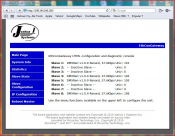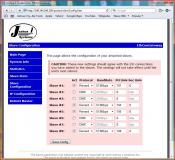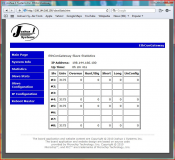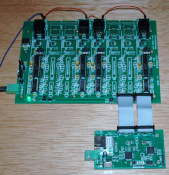We are proud to announce that EthConGateway was introduced last weekend at Light-Up-Ohio (USA).
EthConGateway is a large original project that includes:
1) A New Open-Source Vixen E1.31 (Streaming DMX over Ethernet) Plugin
2) A New Open-Source/Open-Schematic 10/100Base-T Ethernet 40MIPS 16 bit PIC processor board called ECG-M24H with HTML management and E1.31 processing capabilities
3) A New Open-Source/Open-Schematic 8 Slave RS-485 I/O board with a 40MIPS 16 bit PIC processor PER slave called ECG-DMXRen8 that supports DMX and Renard protocols and cable wiring.
Please see attachments for screen shots and photos of pre-production boards.
All parts of the project are Open-Source/Open-Schematic under BSD Simple licensing. We will be producing printed circuit boards for sale to the community. Both hardware items will be available bare board, kits, or assembled. We recommend considering purchasing the ECG-M24H in assembled form since it required the use of surface mount technology since the chips used in its design are not available in DIP form.
We are currently building up three additional units and sending them off for beta testing with three DIYC members and expect to have production boards and assembled ECG-M24H available on or before 1 Jul 2010.
Costs for the ECG-M24H are expected to be:
$10 USD bare board
$35 USD board + parts
$40 USD assembled and tested unit
Costs for the ECG-DMXRen8 are expected to be:
$15 USD bare board
$20 USD board + base parts needed for the board (power, oscillator, connector)
$30 USD parts per TWO slaves
So an ECG-DMXRen8 board, base parts, and parts for 8 slaves would be $140 USD. One for only 4 slaves would be $80 USD. Add the assembled ECG-M24H and you have $180 USD and $120 USD respectively.
All of these costs are estimates. We hope to get them lower. They could go a little higher if beta testing finds needed revisions that require additional circuitry.
Now some more details on each part of the project:
J1Sys E1.31 Vixen Plugin
An integral part of this project is a new plugin for Vixen 2.1 and 2.5. This plugin allows the user to transmit events via their Ethernet connection to any (subject to testing) E1.31 compliant listener. E1.31 is the ESTA standard for streaming DMX over Ethernet. The plugin has been written from the ground up to natively implement this protocol and does not depend on any other DLLs or modules. It directly uses the Sockets capability of .Net and is written in C#. The plugin is Open-Source under the BSD Simple license and can be used with our hardware or any other E1.31 hardware. It supports an unlimited number of universes and configurations subject only to the memory and processing power of your computer. It is currently limited to a maximum of 9999 events per instance by Vixen but multiple instances of the plugin can be configured. It allows for transmission via Multicast or Unicast (directly to a static IP) as called for in the E1.31 specification.
ECG-M24H
ECG-M24H is a small 10/100Base-T master controller board designed for the E1.31 protocol and control of slave I/O boards. The design philosophy is to use this board to communicate via HTML for configuration and via UDP for packet reception/transmission. The board includes a powerful PIC24HJ256GP206A 16 bit processor with 256KB of flash and 16KB of RAM. An additional 1MB of flash is supplied in an external SPI flash chip for HTML and configuration storage. It uses an ENC624J600 Ethernet controller chip and communicates with that chip in Parallel Master/Slave mode for speed. The board includes an onboard 3.3V LDO regulator, indicator LEDs, and option jumpers. An ICSP connector is provided for firmware updates. We expect to include a TFTP updating capability in future releases but initially it will require a PICkit 2, PICkit 3, or ICD 3 for updating the firmware.
All software is written in Microchip C30 and can be compiled with the free student/evaluation version of the compiler. All code is currently in C. In future some of the interrupt handlers may be optimized in assembler if needed. The software uses Microchip's free TCP/IP stack. The HTML, CSS, and Javascript needed to operate the system are all included.
Connection to our slave boards is through two 2x8 .100in connectors. These connectors bring 15 unbuffered signals from the processor to the outside world as well as interleaved grounds, 5VDC, and 3.3VDC. As used for our ECG-DMXRen8 boards the signals are configured as 8 slave select lines and the 3 signals (SCLK, MISO, MOSI) for a 9Mbps SPI connection. Initially the boards were built with 2x8 headers that require ribbon cables to connect to the slave board. We will be providing them with headers on the top of the board or with sockets on the bottom of the board so the user can either connect via cables or mount the board as a daughter board on top of their slave board. Our ECG-DMXRen8 is being redesigned for the top mounted daughter board model.
The 15 unbuffered signals can be used by other board designs by us or other people in the future for any applicable interface needs. When we publish our initial schematics you will be able to see the signals available. Care will be needed in designing your board. Most of these signals are 3.3V levels and can only drive minimal loads. Level conversion or buffering would be supplied on the slave board. We hope to work with other people to develop more slave boards for things like RGB LED panel driving etc that could benefit from an Ethernet connection with the capability of supplying over 12 universes (6,144 slots) of data at a 25ms update rate. It could do more but we have tested it at this level for hours with little or no UDP packet loss in a noisy Ethernet environment. If more power is needed we will be developing a 32 bit version (ECG-M32MX) in the future that will be footprint compatible.
The software currently supports E1.31 reception. We will be adding Art-Net II support as well as E1.33 RDM support as it becomes available. Other protocols can be supported as needed.
Power is supplied as either 5VDC or 3.3VDC at either a terminal strip or through one of the slave connectors. If supplied on the 3.3VDC terminals the onboard LDO regulator should be disconnected via jumpers. Measured power usage is approximately .25amp @ 5VDC. This is easily provided by inexpensive wall-wart power supplies.
ECG-DMXRen8
Our ECG-DMXRen8 board is a slave board that can contain up to 8 DMX/Renard slaves. With software updates it should be able to support any RS-485 protocol. Each slave is a dedicated 40MIPS 16 bit PIC128GP202 processor with 128KB of flash and 8KB of RAM. Configuration and universe data is sent to the slaves via a 9Mbps SPI connection. Each slave then independently controls a single RS-485 connection and transmits the data out an RJ-45 connector using the configured protocol and speed to the attached controllers. The hardware includes jumpers to configure the RJ-45 to the DMX or Renard cabling specifications and to enable/disable a terminator and an RDM biasing circuit. Also included is a 1x8 terminal strip next to the RJ-45 connector. This can be used it inject additional signals on unused wires in the cable or for hardwired connection to a different connector or directly to a cable. In our example photo we used this to inject 5VDC on pin 3 to supply power to some modified Renard SS-8 boards for testing.
Even though all chips are mounted in machined sockets we have include ICSP connectors next to each slave. Initial firmware updates will require a PICkit 2, PICkit 3, or ICD 3. We expect to allow remote firmware update via HTML screens on the ECG-M24H in a future release.
All software is written in Microchip C30 and can be compiled with the free student/evaluation version of the compiler. All code is currently in C. In future some of the interrupt handlers may be optimized in assembler if needed.
The current software supports DMX at 250Kbps or Renard at 9.6Kbps, 19.2Kbps, 38.4Kbps, 57.6Kbps, or 115.2Kbps. The hardware is capable of transmitting or receiving RS-485 and the software will include full Remote Device Management (RDM) in a future release.
Power is supplied as either 5VDC or 5VDC and 3.3VDC. If 3.3VDC is supplied then the onboard LDO regulator should be disable with jumpers. Observed power usage is approximately .75amp @ 5VDC. If supplying the ECG-M24H through the 2x8 header the total usage would be approximately 1amp @ 5VDC.
The initial production release will be rearranged from the current board to mount the ECG-M24H as a daughter board rather than connect via ribbon cables.
Release Information
We expect to release all source code and schematics by the end of May 2010 with boards available by the end of June 2010.
We are also in discussions with other lighting control software authors to provide E1.31 plugins for other systems. Please contact us with information on lighting software that you would like to see supported.
Please watch this thread or visit our website www.j1sys.com for further updates.
-Ed
Edward D. Bryson
Joshua 1 Systems Inc.
Knoxville TN USA
EthConGateway is a large original project that includes:
1) A New Open-Source Vixen E1.31 (Streaming DMX over Ethernet) Plugin
2) A New Open-Source/Open-Schematic 10/100Base-T Ethernet 40MIPS 16 bit PIC processor board called ECG-M24H with HTML management and E1.31 processing capabilities
3) A New Open-Source/Open-Schematic 8 Slave RS-485 I/O board with a 40MIPS 16 bit PIC processor PER slave called ECG-DMXRen8 that supports DMX and Renard protocols and cable wiring.
Please see attachments for screen shots and photos of pre-production boards.
All parts of the project are Open-Source/Open-Schematic under BSD Simple licensing. We will be producing printed circuit boards for sale to the community. Both hardware items will be available bare board, kits, or assembled. We recommend considering purchasing the ECG-M24H in assembled form since it required the use of surface mount technology since the chips used in its design are not available in DIP form.
We are currently building up three additional units and sending them off for beta testing with three DIYC members and expect to have production boards and assembled ECG-M24H available on or before 1 Jul 2010.
Costs for the ECG-M24H are expected to be:
$10 USD bare board
$35 USD board + parts
$40 USD assembled and tested unit
Costs for the ECG-DMXRen8 are expected to be:
$15 USD bare board
$20 USD board + base parts needed for the board (power, oscillator, connector)
$30 USD parts per TWO slaves
So an ECG-DMXRen8 board, base parts, and parts for 8 slaves would be $140 USD. One for only 4 slaves would be $80 USD. Add the assembled ECG-M24H and you have $180 USD and $120 USD respectively.
All of these costs are estimates. We hope to get them lower. They could go a little higher if beta testing finds needed revisions that require additional circuitry.
Now some more details on each part of the project:
J1Sys E1.31 Vixen Plugin
An integral part of this project is a new plugin for Vixen 2.1 and 2.5. This plugin allows the user to transmit events via their Ethernet connection to any (subject to testing) E1.31 compliant listener. E1.31 is the ESTA standard for streaming DMX over Ethernet. The plugin has been written from the ground up to natively implement this protocol and does not depend on any other DLLs or modules. It directly uses the Sockets capability of .Net and is written in C#. The plugin is Open-Source under the BSD Simple license and can be used with our hardware or any other E1.31 hardware. It supports an unlimited number of universes and configurations subject only to the memory and processing power of your computer. It is currently limited to a maximum of 9999 events per instance by Vixen but multiple instances of the plugin can be configured. It allows for transmission via Multicast or Unicast (directly to a static IP) as called for in the E1.31 specification.
ECG-M24H
ECG-M24H is a small 10/100Base-T master controller board designed for the E1.31 protocol and control of slave I/O boards. The design philosophy is to use this board to communicate via HTML for configuration and via UDP for packet reception/transmission. The board includes a powerful PIC24HJ256GP206A 16 bit processor with 256KB of flash and 16KB of RAM. An additional 1MB of flash is supplied in an external SPI flash chip for HTML and configuration storage. It uses an ENC624J600 Ethernet controller chip and communicates with that chip in Parallel Master/Slave mode for speed. The board includes an onboard 3.3V LDO regulator, indicator LEDs, and option jumpers. An ICSP connector is provided for firmware updates. We expect to include a TFTP updating capability in future releases but initially it will require a PICkit 2, PICkit 3, or ICD 3 for updating the firmware.
All software is written in Microchip C30 and can be compiled with the free student/evaluation version of the compiler. All code is currently in C. In future some of the interrupt handlers may be optimized in assembler if needed. The software uses Microchip's free TCP/IP stack. The HTML, CSS, and Javascript needed to operate the system are all included.
Connection to our slave boards is through two 2x8 .100in connectors. These connectors bring 15 unbuffered signals from the processor to the outside world as well as interleaved grounds, 5VDC, and 3.3VDC. As used for our ECG-DMXRen8 boards the signals are configured as 8 slave select lines and the 3 signals (SCLK, MISO, MOSI) for a 9Mbps SPI connection. Initially the boards were built with 2x8 headers that require ribbon cables to connect to the slave board. We will be providing them with headers on the top of the board or with sockets on the bottom of the board so the user can either connect via cables or mount the board as a daughter board on top of their slave board. Our ECG-DMXRen8 is being redesigned for the top mounted daughter board model.
The 15 unbuffered signals can be used by other board designs by us or other people in the future for any applicable interface needs. When we publish our initial schematics you will be able to see the signals available. Care will be needed in designing your board. Most of these signals are 3.3V levels and can only drive minimal loads. Level conversion or buffering would be supplied on the slave board. We hope to work with other people to develop more slave boards for things like RGB LED panel driving etc that could benefit from an Ethernet connection with the capability of supplying over 12 universes (6,144 slots) of data at a 25ms update rate. It could do more but we have tested it at this level for hours with little or no UDP packet loss in a noisy Ethernet environment. If more power is needed we will be developing a 32 bit version (ECG-M32MX) in the future that will be footprint compatible.
The software currently supports E1.31 reception. We will be adding Art-Net II support as well as E1.33 RDM support as it becomes available. Other protocols can be supported as needed.
Power is supplied as either 5VDC or 3.3VDC at either a terminal strip or through one of the slave connectors. If supplied on the 3.3VDC terminals the onboard LDO regulator should be disconnected via jumpers. Measured power usage is approximately .25amp @ 5VDC. This is easily provided by inexpensive wall-wart power supplies.
ECG-DMXRen8
Our ECG-DMXRen8 board is a slave board that can contain up to 8 DMX/Renard slaves. With software updates it should be able to support any RS-485 protocol. Each slave is a dedicated 40MIPS 16 bit PIC128GP202 processor with 128KB of flash and 8KB of RAM. Configuration and universe data is sent to the slaves via a 9Mbps SPI connection. Each slave then independently controls a single RS-485 connection and transmits the data out an RJ-45 connector using the configured protocol and speed to the attached controllers. The hardware includes jumpers to configure the RJ-45 to the DMX or Renard cabling specifications and to enable/disable a terminator and an RDM biasing circuit. Also included is a 1x8 terminal strip next to the RJ-45 connector. This can be used it inject additional signals on unused wires in the cable or for hardwired connection to a different connector or directly to a cable. In our example photo we used this to inject 5VDC on pin 3 to supply power to some modified Renard SS-8 boards for testing.
Even though all chips are mounted in machined sockets we have include ICSP connectors next to each slave. Initial firmware updates will require a PICkit 2, PICkit 3, or ICD 3. We expect to allow remote firmware update via HTML screens on the ECG-M24H in a future release.
All software is written in Microchip C30 and can be compiled with the free student/evaluation version of the compiler. All code is currently in C. In future some of the interrupt handlers may be optimized in assembler if needed.
The current software supports DMX at 250Kbps or Renard at 9.6Kbps, 19.2Kbps, 38.4Kbps, 57.6Kbps, or 115.2Kbps. The hardware is capable of transmitting or receiving RS-485 and the software will include full Remote Device Management (RDM) in a future release.
Power is supplied as either 5VDC or 5VDC and 3.3VDC. If 3.3VDC is supplied then the onboard LDO regulator should be disable with jumpers. Observed power usage is approximately .75amp @ 5VDC. If supplying the ECG-M24H through the 2x8 header the total usage would be approximately 1amp @ 5VDC.
The initial production release will be rearranged from the current board to mount the ECG-M24H as a daughter board rather than connect via ribbon cables.
Release Information
We expect to release all source code and schematics by the end of May 2010 with boards available by the end of June 2010.
We are also in discussions with other lighting control software authors to provide E1.31 plugins for other systems. Please contact us with information on lighting software that you would like to see supported.
Please watch this thread or visit our website www.j1sys.com for further updates.
-Ed
Edward D. Bryson
Joshua 1 Systems Inc.
Knoxville TN USA






